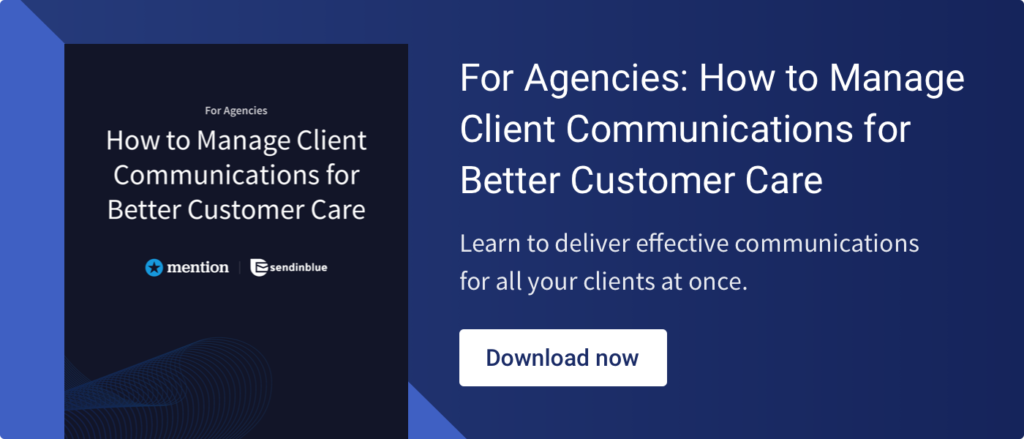

As an agency, it’s important to always be looking for new opportunities to add value for your clients. After all, client relationships are the lifeblood of any agency.
Email marketing is one of those areas that’s ripe for agency intervention. It’s still one of the most popular marketing channels by far for businesses to communicate with their clients.
But where do agencies fit into the equation? I’m glad you asked. 🙂
This article outlines a process with which agencies can help clients create better emails and build stronger relationships in the process.
By following these steps, you are sure to make your clients more successful and keep them coming back to you for more!
Step 1: Perform an Email Content Audit
Most businesses out there use email marketing in some way. But, that doesn’t mean that they’re doing a good job. That goes for your clients as well.
The best place to start helping clients with their email marketing strategy is to perform an email content audit. Essentially, you should take a look through their past email campaigns and make sure they’re following general email best practices.
Specifically, you should be looking at the following areas:
- Are their emails in line with the rest of their brand? This can include colors, logos, content, and even illustrations or images. All of your client’s emails should feel consistent with their website and business experience.
- Are they following design best practices? Make sure that they are making their CTAs stand out with coloring and placement, avoiding the overuse of calls to action (CTAs), making the layout follow a logical hierarchy, and staying away from overflowing emails with too much information in one email campaign.
- Are they including actionable CTAs with a clear goal? Your client’s customers should never be left wondering why they received a certain email. There should always be a clear goal and actionable CTA that lets the recipient know what you want from them.
Step 2: Teach Email Content Best Practices
After the audit, you should have a better idea of the areas of improvement your clients need to address. This is where your expertise as an agency will truly begin to produce results.
To start, create a training plan or set of recommendations that will help your clients create better marketing email campaigns.
These recommendations should not only teach clients the best practices surrounding email content, but also the reasons why they are important.
You should include the following for the above-mentioned points:
- Brand Consistency: It should be immediately clear to your client’s customers who your email is coming from. Brand consistency provides immediate context for the recipient, which eliminates wasted time on their end trying to figure out where the email came from. Consistency also builds trusts with recipients because they know what to expect when they open your client’s messages.
- General Design: People get too many emails everyday in their inbox to waste time engaging with poorly designed messages. Following general design best practices is essential for your clients if they want to see real results with email marketing and cut through their customers’ cluttered inboxes.
- CTA Strategy: Your clients need to have a clear reason to send an email to their contacts. It’s too easy for their customers to delete (or worse, send to spam) any emails that don’t provide immediate value. That’s why it’s so important for your clients to have a clear goal and purpose for every email and CTA they create.
Looking through your client’s email content should have also given you better insight into the types of emails they have been (or should be) sending out to their customers. That brings us to the next step.
Step 3: Identify Potential for Templatization
Like most other areas of life, email marketing involves a fair amount of repetition. But, thanks to email marketing tools like Sendinblue, repetition doesn’t have to feel like banging your head against the wall.
Source: Giphy
In fact, it’s an opportunity for you to help make your clients’ lives easier!
By identifying emails that follow a similar structure or goal, you can create templates that minimize the amount of design team your client needs to spend on those emails.
This also makes it much easier to train clients on implementing the recommendations and best practices that were mentioned in steps 1 and 2.
Bonus Agency Tip: If you set up your own white label email marketing solution with Sendinblue, you can create templates from a central account and push them to specific clients that are using your white label service!
Step 4: Perform Email List and Engagement Audit
After looking through all the content, it’s also a good idea to look at your client’s contact database and past email engagement metrics.
Specifically, you should consider the following 2 questions:
- How does your client divide up their list of contacts? It’s not the best idea for your clients to send email campaigns out to their entire list of contacts. Ideally, they should be dividing their database up into smaller and more relevant segments.
- Who is engaging with your client’s email campaigns? Try to find any segments that have shown higher levels of engagement. This will give you insight into what’s already working and where you might be able to improve.
Step 5: Create a segmentation strategy
Now that you have a good idea of what your client’s contact database and engagement patterns look like, it’s time to strategize.
Since your client should already have email design and content best practices down, you can move on to one of the most important aspects of email marketing: email segmentation.
Segmenting contacts into smaller, more relevant lists makes email content personalization much easier. This leads to higher engagement with campaigns because the content in emails is more relevant to the recipient.
Segment types may vary depending on your client’s business type, but some common segmentation methods include:
- Gender preference
- Geographic location
- Returning vs. New Customers
- Purchase Behavior
- Lead score
It’s important that you work with your client to figure out which segments will work best for their business.
Step 6: Continuously Evaluate and Improve the Process
Email marketing (or any digital marketing for that matter) is an iterative process that involves continued improvement.
Make sure to schedule follow-ups with your clients to help them analyze the performance of their email marketing strategy. This will help reinforce their trust in your agency while improving ROI on their marketing efforts.
 Deutsch
Deutsch






















